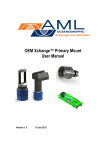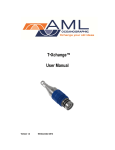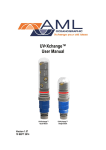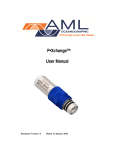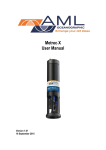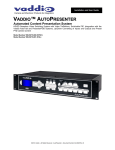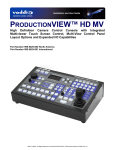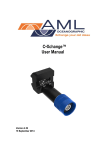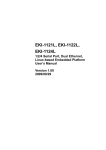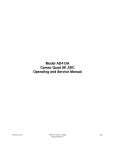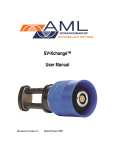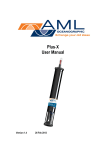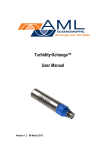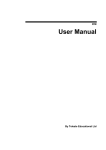Download User Manual
Transcript
MicroX User Manual Version 1.96 22 June 2015 Revision History Revision Date Description Author Version 1.6 07 November 2012 Erika Ladouceur Version 1.61 06 December 2012 Updated manual to include Turbidity•Xchange™and updated product codes. Updates. Version 1.7 14 February 2013 Added NMEA-like output format Dustin Olender Version 1.8 10 June 2013 Format revision and updates Jehan Zouak Version 1.9 26 August 2013 Minor edits Jehan Zouak Version 1.91 07 October 2013 Corr’d NMEA; Added change units commands to appendix Dustin Olender Version 1.915 11 February 2014 Edited page 4 Jehan Zouak Version 1.92 12 February 2014 Added UV•Xchange reference Chris Bueley Version 1.93 16 July 2014 Added Ordering Codes Jehan Zouak Version 1.94 14 November 2014 Updated current draw table Quinton Calverley Version 1.95 28 May 2015 Updated for SeaCast 4 Andrew Beak-Taylor Version 1.96 22 June 2015 Updated technical specifications Jehan Zouak Erika Ladouceur User Manual for AML Oceanographic’s MicroX Table of Contents General Description of the Instrument .............................................................................................. 2 Where Do I Start? ............................................................................................................................ 3 Shipping & Receiving ....................................................................................................................... 4 Receiving an Instrument .............................................................................................................. 4 Returning an Instrument to the Factory........................................................................................ 4 Using the Instrument ........................................................................................................................ 5 Pressure Ratings ......................................................................................................................... 5 Pre-Deployment Procedures........................................................................................................ 5 Configuring Sampling Parameters using SeaCast ....................................................................... 6 Configuring Sampling Parameters through the Terminal ............................................................. 6 Accounting for Atmospheric Pressure Variations at the Surface .................................................. 6 Monitoring Real Time Data .......................................................................................................... 7 Post-Deployment Procedures ...................................................................................................... 7 Configuring the Instrument for Data on Power Up ....................................................................... 8 Disabling Data on Power Up ........................................................................................................ 8 Maintaining the Instrument ............................................................................................................... 9 Periodic Maintenance .................................................................................................................. 9 Communications .............................................................................................................................10 PC Settings .................................................................................................................................10 Output Formats ...........................................................................................................................10 Default Output Format...........................................................................................................10 NMEA-like Output Format .....................................................................................................12 Example Outputs ..................................................................................................................13 Support ...........................................................................................................................................14 Troubleshooting ..........................................................................................................................14 Contact AML Oceanographic ......................................................................................................15 Appendices .....................................................................................................................................16 Commands .................................................................................................................................16 Communications Commands ................................................................................................16 Sampling Rate Commands ...................................................................................................16 Output Format Commands....................................................................................................17 General Commands ..............................................................................................................17 Technical Specifications .............................................................................................................18 Ordering Codes ...............................................................................................................................21 Warranty .........................................................................................................................................22 Technical Overview Drawings .........................................................................................................23 1 User Manual for AML Oceanographic’s MicroX General Description of the Instrument The AML Oceanographic X•Series instruments and Xchange™ sensors are a major advancement in ocean instrumentation. Swappable and interchangeable sensors dramatically improve the capabilities of ocean instrumentation in the following ways: Change the instrument sensor types while at sea within seconds, and without tools. A CTD can be changed to a sound speed profiler by exchanging sensor heads. To optimize the resolution and accuracy of sensor data, sensors can be swapped to change the measurement range. For example, a 6000 dBar P•Xchange pressure sensor can be swapped with a 500 dBar P•Xchange sensor; the salt water C•Xchange conductivity sensor can be swapped for a fresh water C•Xchange conductivity sensor. Sensors from one instrument can be swapped to another instrument to maintain missioncritical capabilities. Calibrated sensors can be sent from the factory to the instrument. The instrument is not pulled from active duty for calibration. Spare sensors ensure that an instrument can be immediately returned to active duty after sustaining damage. All calibration and traceability data resides within each Xchange™ sensor. Calibration data for all sensors is available from the instrument, and calibration certificates can be printed from AML Oceanographic SeaCast software when the instrument is connected. Logged data is stamped with sensor traceability and instrument configuration data. Only Xchange™ sensors are sent for calibration, leaving the instrument working in the field. Micro•X is the miniature, single-sensor, externally powered, data via cable instrument of the X•Series family. It is designed primarily for sonar transducer array, and hull mounted applications. Communications with the Micro•X are accomplished with RS-232 or RS-485. Sampling rates are programmable by time (25 Hz to every 24 hours). Micro•X is equipped with one Xchange™ sensor port. There are two options available for this port: A primary Xchange™ sensor port (C•Xchange or SV•Xchange) A secondary Xchange™ sensor port (T•Xchange, P•Xchange, Tu•Xchange, UV•Xchange) A Micro•X with a primary Xchange™ sensor port cannot accept Xchange™ sensors designed for a secondary port, and vice versa. 2 User Manual for AML Oceanographic’s MicroX Where Do I Start? AML Oceanographic’s X•Series instruments ship with several manuals on the USB stick: An instrument manual (this Micro•X manual) providing an overview on how to use and maintain the instrument; A SeaCast manual providing instructions on how to use the software to configure the instrument and review instrument data; Xchange™ sensor manuals (C•Xchange, SV•Xchange, P•Xchange, T•Xchange, Tu•Xchange, UV•XchangeT) providing overviews on how to install and maintain each of the Xchange™ sensors; If you are configuring an instrument for field use or lab testing, begin with the SeaCast manual. If you are performing instrument maintenance, begin with the instrument manual. If you are planning to swap an Xchange™ sensor, read the Xchange™ manual corresponding to your sensors. If you are planning to use Micro•X with UV•Xchange, refer to the UV•Xchange manual. 3 User Manual for AML Oceanographic’s MicroX Shipping & Receiving Receiving an Instrument When receiving an instrument, perform the following steps to ensure the instrument will be ready for deployment when required: Inspect the shipping container, looking for signs of damage. Damage to the shipping container could indicate damage to the instrument inside. The shipping package should include all of the following items o Micro•X board set (2 circuit boards) o One sensor port blanking plug o CD with manuals and documentation Inspect for damage o Check the connector sockets for corrosion, dirt, and salt deposits o Check the circuit boards for damage o Check the pressure case for dents and scrapes o Check the sensors for cracks or bends Ensure the Xchange™ sensor is installed tightly onto its mount. The blue locking sleeve should be tight, and sitting less than 1mm from the instrument end cap. Connect the instrument to a computer with the data cable and perform a scan or monitor if using SeaCast. Returning an Instrument to the Factory If shipping for repair or recalibration, obtain an RMA number from the service centre. Pack the instrument in its original shipping box to prevent damage during shipping. An RMA number can be requested using the contact options given in the Support section of this manual. 4 User Manual for AML Oceanographic’s MicroX Using the Instrument Pressure Ratings Pressure ratings are given for Xchange™ sensors and the entire instrument. Deployments should never exceed the lower of these two pressure ratings. For example, a 500m instrument equipped with a 6000 dBar (0-6000m) P•Xchange™ sensor is limited to deployments of 500m depth or less. Similarly, a 6000m instrument equipped with a 500 dBar (0-500m) P•Xchange™ sensor is also limited to deployments of 500m depth or less. It is desirable to optimize the accuracy of pressure measurements by using a P•Xchange™ sensor with a pressure the depth of the deployment. Caution: Do not exceed the specified pressure ratings of the P•Xchange™ sensor, Turbidity•Xchange™ sensor, or the instrument housing. Overpressure can result in damage to the sensors and the instrument. Pre-Deployment Procedures Upon Receipt o Use the Shipping and Receiving instructions to verify the condition of the instrument. o Verify that all sensor calibrations are valid for the duration of the deployment. If not, swap the Xchange™ sensors for sensors with valid calibrations or send the Xchange™ sensors to a service centre for recalibration. o Lightly lubricate the underwater connectors with 3M silicone spray or equivalent. Before leaving the jetty o If applicable, verify the P•Xchange™ pressure range is correct for the deployment. o Connect the instrument to a computer using the data cable. 5 User Manual for AML Oceanographic’s MicroX Configuring Sampling Parameters using SeaCast SeaCast is free software provided for use with AML Oceanographic instruments. It can be used to set up an instrument for profiling or monitoring data, as well as downloading, graphing, and exporting the collected data. Full details on the instrument configuration process and the software’s capabilities can be found in the SeaCast manual. Configuring Sampling Parameters through the Terminal Instruments can also be configured for deployment using a terminal emulation program like HyperTerminal, RealTerm, or Tera Term. Communications with the instrument must be established using the correct communications port and settings. The communications settings are 8 data bits, 1 stop bit, no parity, no flow control, and the desired baud rate. The following steps must be completed by issuing text commands: Step Set Sampling Parameters Possible Commands SET SAMPLE RATE CONTINUOUS SET SAMPLE RATE 5/s SET P INC 1 SET SOUND INC 2 The above table provides example commands only; many additional sampling regimes can be established using available commands. Please consult the Commands section of the Appendix for full syntax details on the commands you wish to use. Accounting for Atmospheric Pressure Variations at the Surface Climate and altitude changes can create fluctuations in atmospheric (barometric) pressure. AML's pressure sensors are sensitive enough to detect these variations. When this happens, the instrument's pressure channel may not read exactly zero when data is taken prior to submersion in the water. Nearly all absolute pressure sensors experience atmospheric pressure offsets if they are sufficiently sensitive. To compensate for this atmospheric pressure offset, AML instruments have the ability to reset the pressure sensor's zero point. This can be initiated using AML Oceanographic SeaCast software or a Terminal emulator command. The compensation does not affect the calibration of the pressure sensor, and can be turned off or recalculated at any time. The compensation factor is applied through the entire calibrated pressure range. Note that this compensation cannot be applied to a built-in Paroscientific Digiquartz sensor, as found in bathyMetrec•X. Once the atmospheric pressure compensation is applied, it will be applied to all pressure sensor data until it is turned off or recalculated. The setting is written to memory, so it remains set when the instrument is powered down. Using SeaCast Refer to the SeaCast User Manual for instructions on enabling "Zero Depth." 6 User Manual for AML Oceanographic’s MicroX Using a Terminal Emulator Establish serial communications with the instrument on your computer. Refer to the "Communications" section of this manual for more information. Once connection is established, ensure the instrument is stationary, and is not submerged in water. To turn ON Atmospheric pressure compensation, issue the ZERO ON command. This will calculate and apply the offset required to compensate for current atmospheric pressure conditions. To turn OFF Atmospheric pressure compensation, issue the ZERO OFF command. This will disable the offset. Issuing the ZERO command again will calculate a new offset based on current conditions Monitoring Real Time Data Ensure the pre-deployment procedures have been completed (see page 4). Ensure that the desired sampling settings have been selected and applied. Plug the data/power cable into the instrument. If you power the instrument over a long cable, please note the following: o Voltage drop due to cable resistance increases with cable length. The voltage drop on a standard AML cable, with a standard Micro•X, is about 1 volt per 100m of cable. o The instrument’s lowest voltage is 8 volts. o The instrument’s maximum voltage is 26 volts. o The voltage at the instrument, while sampling, must be above the shutdown level for the instrument to operate. If using a Pressure•Xchange™ sensor, use the ZERO command while the instrument is in air (NOT submerged) to zero the barometric pressure offset. Begin monitoring data using SeaCast or HyperTerminal. Send the instrument down to the desired depth and return it to the surface. Post-Deployment Procedures When the instrument is pulled from the water it should be rinsed with fresh water. Dry the area around the connectors with a clean cloth or compressed air prior to disconnecting the plugs or cables. Do not blow compressed air into the Pressure•Xchange™ sensor. Doing so may damage the sensitive pressure transducer diaphragm. Remove the cable. Place dummy plug in the connector to protect it. Dry the instrument and stow it securely. 7 User Manual for AML Oceanographic’s MicroX Configuring the Instrument for Data on Power Up Perform the following steps: Open a terminal emulation program such as HyperTerminal. Ensure the serial port has been selected in the program. If the instrument has been set to a specific baud rate with the SET DETECT command, the terminal emulation program must be configured for that baud rate. Connect the instrument to the computer using the data/power cable. Using the terminal emulation program, issue the following commands to the instrument: o SET STARTUP NOHEADER (disables the power up header information) o SET STARTUP MONITOR (enables data output on power up) o SET SAMPLE RATE 2/S (sets the desired sampling rate) o SET DETECT 07 (sets fixed 38400 baud rate) Note: Details on the SET DETECT command can be found in the appendix. Unplug the data/power cable from the instrument to turn the instrument off. Plug the data/power cable into the instrument to turn the instrument on. Disabling Data on Power Up Perform the following steps: Open a terminal emulation program such as HyperTerminal. Ensure the serial port has been selected in the program. If the instrument has been set to a specific baud rate with the SET DETECT command, the terminal emulation program must be configured for that baud rate. Connect the instrument to the computer using the data/power cable. Unplug the data/power cable from the instrument to turn the instrument off. Hold down the <ENTER> key. Plug the data/power cable into the instrument to turn the instrument on. Release the <ENTER> key once the prompt ‘>’ is displayed. Using the terminal emulation program issue the following commands to disable data on power up: o SET STARTUP HEADER (enables the power up header information) o SET STARTUP PROMPT (disables data output on power up) o SET SAMPLE RATE 2/S (selects the desired sampling rate) o SET DETECT A7 (sets 10 autobaud attempts then defaults to 38400 baud) Note: Details on the SET DETECT command can be found in the appendix. Unplug the data/power cable from the instrument to turn the instrument off. 8 User Manual for AML Oceanographic’s MicroX Maintaining the Instrument Periodic Maintenance Periodic preventative maintenance will prolong the life of the instrument. The following steps are recommended: If the instrument is very dirty or oily, allow it to soak in warm, soapy water before cleaning with a rag or soft brush. When finished, rinse with fresh water to remove any residual soap or dirt. Before each use: o Check for proper installation of the Xchange™ sensor. o Check for nicks and cuts on the cable. After each use: o Clean and rinse the instrument using fresh water. o Dry the instrument completely, and store it in a cool, dry place. Monthly: o Lightly lubricate the connector contacts with 3M silicone spray or equivalent. Avoid the use of grease. It can create internal pressure and push past the connector seals on the pins. o Lubricate the end cap retainer rings with silicone grease. Yearly: o Send the instrument or Xchange™ sensors to a service centre for diagnostics and re-calibration 9 User Manual for AML Oceanographic’s MicroX Communications PC Settings Micro•X will communicate with either RS-232 or RS-485 serial connections depending on how the instrument was ordered from the factory. The computer to which the instrument is connected must be set up as follows: 8 bits 1 stop bit No parity No hardware handshaking Baud rate of 600, 1200, 2400, 4800, 9600, 19,200 or 38,400 baud After power up, Micro•X will wait for an ASCII carriage return. The instrument will automatically detect whether communications are RS-232 or RS-485 as well as the baud rate. Output Formats Output formats can be modified. If the required modifications are not supported by the commonly used command list in the next section, please contact the factory for support with custom output formats. Formatting can be changed in the following ways: The number of decimal places for each channel Turn on or off o power up information (header) o automatic monitoring on power up Default Output Format The output from Micro•X is space delimited values. The following table shows the output units for each Xchange™ sensor: Sensor Units Default Format SV•Xchange™ m/s 1234.567 Conductivity•Xchange™ mS/cm 12.346 Pressure•Xchange™ dBar 1234.56 Temperature•Xchange™ C 12.345 Turbidity•Xchange™ NTU 1234.56 UV•Xchange™ - 1 (1 indicates UV on, 0 indicates UV off) 10 User Manual for AML Oceanographic’s MicroX Default Example Outputs Example outputs for a sound velocity Xchange™ sensor are shown below. User inputs in the output capture shown below are in bold type. Micro.X Sound Velocity Version 1.01 SN:007797 AML Oceanographic Ltd. SV.Xchange Sensor SN:131190, Calibrated 01/22/10 >scan 1475.847 >monitor 1475.857 1475.853 1475.881 1475.850 1475.870 1475.859 >display options [Instrument] Type=Micro.X Sound Velocity SN=007797 Firmware=1.01 SampleUnits=continuous SampleInterval=0 DisplayHeader=yes StartupMode=Prompt DetectionMode=a5 SVAveraging=1 RX=on TrailingSpace=off SQ=off ConductivityFormat=23 SVFormat=43 StartupRawReal=Real ConductivityUnits=mS/cm SVUnits=m/s AddressMode=off AddressByte=09 SerialParity=none SerialEcho=on CommunicationsDelay=0 SVZeroSuppressionUnits=minute SVZeroSuppressionInterval=1 [Channel 1] SensorName1=SV.Xchange BoardSN1=007797 SensorSN1=131190 CalDate1=01/22/10 CalBy1=MD~ CalRange1=1375-1625 m/s CalAccuracy1=-0.008 m/s avg A=-2.171728E-07 B= 9.828663E-08 C=-5.891780E-07 D= 1.966747E-07 E=-1.887395E-05 F= 1.972120E-07 > 11 User Manual for AML Oceanographic’s MicroX NMEA-like Output Format Micro•X can be configured to produce an output similar to that regulated by the National Marine Electronics Association (NMEA) as follows: $AML,TUN,301.2,SN,600013*38 Where $AML is always present, TUN identifies the next value as turbidity in NTU, and the sensor serial number is also displayed. * identifies the end of the data, and the following two characters are the NMEA checksum in hexadecimal. It is calculated by XORing all the characters in the string except the $ and * characters. The following table lists all format codes. Code CM CS CR DOM PD PP PM PF SVM SVF SN TC TF TUN Description Conductivity Conductivity Conductivity Ratio Dissolved Oxygen Pressure Pressure Pressure Pressure Sound Velocity Sound Velocity Serial Number Temperature Temperature Turbidity Units milliSiemens/centimeter (mS/cm) Siemens/meter (S/m) --milligrams/Liter (mg/L) deciBar (dBar) Pressure per square inch (psi) Meters (m) Feet (ft) meters/second (m/s) feet/second (ft/s) --Celsius (C) Fahrenheit (F) Nephelometric Turbidity Units (NTU) To configure NMEA-like output, the following commands are used with a terminal emulation program, such as Hyperterminal: o SET NMEAON (turns on NMEA-like format) o SET NMEAOFF (turns off NMEA-like format) The AUTOMONITOR command is often used when NMEA-like output is enabled. It allows Monitor mode to be automatically entered after a period of no activity on the user terminal. Time is 0 for no timeout (i.e. the command line waits forever for a command) to 255 seconds. To configure AUTOMONITOR the following commands are used: o SET AUTOMONITOR 10 (Monitor starts after 10 sec of inactivity) o SET AUTOMONITOR 30 (Monitor starts after 30 sec of inactivity) o SET AUTOMONITOR 0 (Monitor deactivated) 12 User Manual for AML Oceanographic’s MicroX Example Outputs >set nmeaon NMEA-like output enabled >monitor $AML,TUN,514.3,SN,600013*3B $AML,TUN,514.4,SN,600013*3C $AML,TUN,514.2,SN,600013*3A $AML,TUN,514.1,SN,600013*39 > set nmeaoff NMEA-like output disabled >monitor 514.6 514.8 514.9 515.1 >set automonitor 10 Automonitor set to10 sec 13 User Manual for AML Oceanographic’s MicroX Support Troubleshooting Instrument fails to communicate: Is the connector damaged? Check the cables o Is the data/power cable connected to the instrument and computer? o Are there any cuts in the cable? o If using a cable other than an AML cable, it should be configured as a null modem cable. o If using multiple cable lengths, the extensions should not be configured as null modem cables. If using external power over a long cable, check the voltage drop over the cable. Measure the voltage across a 10 watt, 27Ω resistor across pins 1 and 4 of the cable. The voltage should be between 9.9 and 26 volts. Are the communication settings in the program used on the computer correct? o Comm port selection o 8 bits o 1 stop bit o No parity o No hardware flow control o Baud rate between 600 and 38,400 baud Are the communication settings in the instrument correct? o Was the instrument specifically set to one baud rate last time? If so, use that baud rate to resume communications. o Was the instrument set to only RS-232 or only RS-485 last time? If so, resume communications in the required protocol. o Was the instrument set to RX OFF last time? If so, a carriage return must be sent to the instrument immediately after power is applied to interrupt this mode. o Was the instrument set to monitor on power up mode? If so, a carriage return must be sent to the instrument immediately after power is applied to interrupt this mode. To interrupt monitor on power up, hold down the ENTER key while applying power to the instrument Instrument generates noisy data: Is the connector damaged, dirty, or corroded? If connected to external power, is there noise on the power supply? Switch-mode power supplies are common sources of noise. Nearby EMI sources such as electric motors, generators, and transformers can create noise. If possible, move the instrument and its cables away from the noise source. Are the sensor/s clean? Are there bubbles on or in the sensor/s? Are the sensor/s damaged? Is there something nearby affecting the water temperature? 14 User Manual for AML Oceanographic’s MicroX Contact AML Oceanographic Service To request an RMA or technical support Email: [email protected] Phone: 1-250-656-0771 Phone: 1-800-663-8721 (NA) Fax: 1-250-655-3655 Sales For all general sales inquiries Email: [email protected] Phone: 1-250-656-0771 Phone: 1-800-663-8721 (NA) Fax: 1-250-655-3655 Website http://www.AMLoceanographic.com Customer Portal My AML Oceanographic is AML's online data centre. This secure area within our website is designed to offer one easy location for interested individuals and organizations - distributors, customers, prospects, and other members of our community - to manage their interactions with AML. My AML Oceanographic will allow you to: View and manage your assets (instruments and sensors) Consult instrument diagnostic summaries View and download calibration and conformity certificates View and manage your technical support cases Consult and download sales estimates, sales orders, and invoice copies View account balances and generate account statements Assess inventory availability at AML To access the Customer Portal, please navigate to the Support button - located on the top right of the AML Oceanographic home page - select Customer Centre from the options on the drop down menu and follow the instructions provided. Mailing and Shipping Address AML Oceanographic 2071 Malaview Ave. Sidney, BC, Canada V8L 5X6 15 User Manual for AML Oceanographic’s MicroX Appendices Commands When using SeaCast, the full command set is not usually necessary. However, text commands are available. Below is a listing of commonly used commands. Note that some commands are only available on instruments equipped with the appropriate Xchange™ sensors. Communications Commands Command DISPLAY FORCE DISPLAY DETECT SET DETECT a b Description Displays current com mode (ie RS232, RS485, AUTO) Displays the baud rate detection settings. Sets the baud rate detection. “a” sets the number of autobaud detection attempts before the instrument reverts to the default baud rate set by “b.” Setting ‘a’=0 forces the instrument to a fixed baud rate determined by “b.” ‘”b”= 1 = 600 baud 4 = 4800 baud 7 = 38400 baud 2 = 1200 baud 5 = 9600 baud 8 = 57600 baud 3 = 2400 baud 6 = 19200 baud 9 = 115200 baud Requires Sampling Rate Commands Command DISPLAY SAMPLE RATE SET SAMPLE n t SET SV ZEROSUPPRESSION n [ seconds | minutes ] Description Displays the time-based sampling rate. Sets the desired sampling rate. “n” is a number and “t” is the time units. Using the slash ( / ) character should be read as "per." For instance, 5 s means sampling happens every 5 seconds. 5/s means 5 samples per second. Examples are: SET S C sets the sampling to continuous (25 Hz) SET S 5 /s 5 samples per sec SET S 1 s Sample 1 time every 1 second SET S 2 /m 2 samples per minute SET S 5 m Sample 1 time every 5 minutes SET S 2 /h 2 samples per hour SET S 24 h Sample 1 time every 24 hours Suppresses 0 m/s SV readings for n seconds or minutes up to a maximum of 900s or 15m. Instead, the last non-zero reading is displayed until n seconds or minutes have passed or the next non-zero SV reading resets the timer. Examples are as follows: SET SV ZEROSUPPRESSION 10 seconds Suppresses 0 m/s SV readings for up to 10 seconds or until next non-zero reading. DISPLAY ZEROSUPPRESSION SV SET SV ZEROSUPPRESSION 1 minute Suppresses 0 m/s SV readings for up to 1 minute or until next non-zero reading. Displays the zero suppression setting. The zero suppression setting is also included in the output from a DISPLAY OPTIONS command. 16 Requires User Manual for AML Oceanographic’s MicroX Output Format Commands Command DISPLAY STARTUP SET LATITUDE dd.dddddd SET PRESSURE UNITS x/y SET TEMPERATURE UNITS x/y SET STARTUP PROMPT SET STARTUP SCAN SET STARTUP MONITOR SET STARTUP NOHEADER SET STARTUP HEADER SET NMEAON SET NMEAOFF SET AUTOMONITOR n Description Displays the power up output settings. Sets the current latitude within a range of -90 to +90 degrees. Latitude is used in calculating depth from pressure. Contact AML for more information. Sets units for real output to x/y. Where x/y = dbar, psi, metres, feet. When changing units to feet or metres the user must set latitude, as the depth calculation corrects for surface gravity. Contact AML for more information Set units for real output to x/y. Where x/y = celsius, fahrenheit. Sets the instrument to wait for user commands on power up. Requires Sets the instrument to output one scan on power up, and then wait for a user command. Sets the instrument to start monitoring data on power up Disables the instrument identification header output on powerup. Enables the instrument identification header output on powerup. Turns NMEA-like format on Turns NMEA-like format off Automatically starts MONITOR after n seconds of command line inactivity (0≤n≤255). If n=0 AUTOMONITOR is disabled General Commands Command SCAN MONITOR VERSION DISPLAY OPTIONS ZERO ON ZERO OFF DETECT Description Measures and outputs one scan of data Scans at the set sampling rate. Displays the instrument identification header. Displays the instrument status and user settings. Corrects the barometric offset to set zero pressure at surface for current barometric pressure. Disables barometric offset. Checks each slot in logger board to identify what is plugged in and displays sensor / board type and serial number or “empty” for each slot. 17 Requires P•X P•X User Manual for AML Oceanographic’s MicroX Technical Specifications Sensors Primary Xchange™ Sensors Type Range Accuracy Precision Resolution Response Time Conductivity•Xchange™ 0 to 2 mS/cm 0.01 mS/cm 0.003 mS/cm 0.001 mS/cm 25 ms at 1 m/s flow rate Conductivity•Xchange™ 0 to 70 mS/cm 0.01 mS/cm 0.003 mS/cm 0.001 mS/cm 25 ms at 1 m/s flow rate Conductivity•Xchange™ 0 to 90 mS/cm 0.01 mS/cm 0.003 mS/cm 0.001 mS/cm 25 ms at 1 m/s flow SV•Xchange™ 1375 to 1625 m/s 0.025 m/s 0.006 m/s 0.001 m/s 47 µs Secondary Xchange™ Sensors Type Range Accuracy Precision Resolution Response Time Temperature•Xchange™ -2°C to 32°C 0.005°C 0.003°C 0.001°C 100 ms Temperature•Xchange™ -5°C to 45°C 0.005°C 0.003°C 0.001°C 100 ms Temperature•Xchange™ 0°C to 65°C 0.005°C 0.003°C 0.001°C 100 ms Pressure•Xchange™ 50, 100, 200, 500, 1000, 2000, 4000, 5000, 6000 dBar 0.05%FS 0.03%FS 0.02%FS 10 ms Turbidity•Xchange™ 0-100 NTU 0.1 NTU 0.1 NTU 0.01 NTU < 0.7s Turbidity•Xchange™ 0-400 NTU 0.2 NTU 0.2 NTU 0.01 NTU < 0.7s Turbidity•Xchange™ 0-1000 NTU 0.5 NTU 0.5 NTU 0.1 NTU < 0.7s Turbidity•Xchange™ 0-3000 NTU 1 NTU 1 NTU 0.1 NTU < 0.7s 18 User Manual for AML Oceanographic’s MicroX Electrical Communications Board o RS-232 Comm board or o RS-485 Comm board Sensor Boards o Sound velocity or conductivity Xchange™ sensor board or o Pressure and temperature Xchange™ sensor board Factory set RS232 or RS485 (½ duplex ASCII) Autobaud to 38,400 Power External Power Supply: 8 to 26 VDC Current Draw at 12VDC Type Sensor Current Draw (mA) Primary Primary Conductivity•Xchange™ SV•Xchange™ 71 63 Secondary Temperature•Xchange™ 45 Secondary Pressure•Xchange™ 36 Secondary Turbidity•Xchange™ 40 Secondary UV•Xchange™ (single stack) 265 Secondary UV•Xchange™ (quad stack) 432 Pressure Case Environmental Limits o Storage: -40°C to 60°C o Usage: -20°C to 45°C Housing Status Type Depth Rating Standard Delrin 500 m Optional Titanium 6000 m Diameter Length 33mm (1.3”) 214mm (8.4”) Weight (in water) Weight (in air) 0.09 Kg (0.2 lbs) 0.24 Kg (0.52 lbs) 0.25 Kg (0.55 lbs) 0.39 Kg (0.86 lbs) Bulkhead Connectors Type Status Pins Sex Material Manufacturer Bulkhead Bulkhead On Delrin housings On titanium housings Micro 6 Micro 6 Female Female Titanium Titanium Subconn Subconn 19 User Manual for AML Oceanographic’s MicroX Sampling Capabilities Frequency o Time: From 25 samples per second to 1 sample per 24 hours Configurations o Single scan or continuous output o On command or autonomous on power up Included Items Micro•X instrument Connector dust cover One sensor blanking plug USB stick with manuals and documentation Software SeaCast 20 User Manual for AML Oceanographic’s MicroX Ordering Codes Instruments PDC-MIX-P1S0-60 Micro•X,Primary (SV or C), 6000 dbar, Titanium pressure housing PDC-MIX-P0S1-05 Micro•X Secondary (P, T, or Tu), 500 dbar, Delrin pressure housing PDC-MIX-P0S1-60 Micro•X Secondary (P, T, or Tu), 6000 dbar, Titanium pressure housing Sensors / Devices XCH-SV-STD SV•Xchange™ (1375-1625m/s) Range XCH-SV-1120 SV•Xchange™ (1100-2000m/s) Range XCH-SV-0520 SV•Xchange™ (500-2000m/s) Range XCH-CND-RA002 C•Xchange™ Right Angle, Ultra Freshwater (0-2mS/cm) Range XCH-CND-RA070 C•Xchange™ Right Angle, Oceanographic (0-70mS/cm) Range XCH-CND-RA090 C•Xchange™ Right Angle, Oceanographic (0-90mS/cm) Range XCH-CND-ST002 C•Xchange™ Straight, Oceanographic (0-70mS/cm) Range XCH-CND-ST070 C•Xchange™ Straight, Ultra Freshwater (0-2mS/cm) Range XCH-TMP-n232 T•Xchange™ (-2 to 32 C) Range XCH-TMP-n545 T•Xchange™ (-5 to 45 C) Range XCH-TMP-065 T•Xchange™ (0 to 65 C) Range XCH-PRS-0050 P•Xchange™ 50 dBar XCH-PRS-0100 P•Xchange™ 100 dBar XCH-PRS-0200 P•Xchange™ 200 dBar XCH-PRS-0500 P•Xchange™ 500 dBar XCH-PRS-1000 P•Xchange™ 1000 dBar XCH-PRS-2000 P•Xchange™ 2000 dBar XCH-PRS-4000 P•Xchange™ 4000 dBar XCH-PRS-5000 P•Xchange™ 5000 dBar XCH-PRS-6000 P•Xchange™ 6000 dBar XCH-TRB-0100-03 Tu•Xchange™ (0-100 NTU) Range, 300m XCH-TRB-0100-05 Tu•Xchange™ (0-100 NTU) Range, 500m XCH-TRB-0400-03 Tu•Xchange™ (0-400 NTU) Range, 300m XCH-TRB-0400-05 Tu•Xchange™ (0-400 NTU) Range, 500m XCH-TRB-1000-03 Tu•Xchange™ (0-1000 NTU) Range, 300m XCH-TRB-1000-05 Tu•Xchange™ (0-1000 NTU) Range, 500m XCH-TRB-3000-03 Tu•Xchange™ (0-3000 NTU) Range, 300m XCH-TRB-3000-05 Tu•Xchange™ (0-3000 NTU) Range, 500m XCH-UV-LLLV UV•Xchange, 3 lower power sideways facing modules + vertical module XCH-UV-V UV•Xchange, single vertical module Accessories MBR-MIX-STD Micro•X mounting bracket assembly 21 User Manual for AML Oceanographic’s MicroX Warranty AML Oceanographic warrants the instrument for a period of two years from the date of delivery. AML will repair or replace, at its option and at no charge, components which are found to be defective. The warranty applies only to the original purchaser of the instruments. The warranty does not apply if the instrument has been damaged, by accident or misuse, and is void if repairs or modifications are made by any other than authorized personnel. This warranty is the only warranty given by AML. No warranties implied by law, including but not limited to the implied warranties of merchantability and fitness for a particular purpose shall apply. In no event will AML be liable for any direct, indirect, consequential, or incidental damages resulting from any defects or failure of performance of any instrument supplied by AML. 22 User Manual for AML Oceanographic’s MicroX Technical Overview Drawings 23 THE INFORMATION CONTAINED IN THIS DRAWING IS THE SOLE PROPERTY OF AML OCEANOGRAPHIC LTD. ANY REPRODUCTION IN PART OR WHOLE WITHOUT THE WRITTEN PERMISSION OF AML OCEANOGRAPHIC LTD IS PROHIBITED REVISION TABLE REV DESCRIPTION DATE BY MICRO X MECHANICAL SPECIFICATION 240 9.4 31.74 1.25 25.40 1.00 88 3.4 125 4.9 27 1.1 Micro X P1S0 AML Part Number: PDC-MIX-P1S0-05/60 33 1.30 Materials: • Delrin - 500m Pressure Rating • Titanium - 6000m Pressure Rating Notes: 1. Only available in Titanium. Delrin shown for legacy products. 2. Shown with SV Xchange sensor (XCH-SV-STD) installed. 224 8.8 22.9 .90 49 1.9 19.3 .76 147 5.8 27 1.1 Micro X P0S1 AML Part Number: PDC-MIX-P0S1-05/60 Materials: • Delrin - 500m Pressure Rating 33 • Titanium - 6000m Pressure Rating 1.30 Note: Shown with P Xchange sensor (XCH-PRS-XXXX where XXXX is max pressure in meters or dBar) installed. 22.8 .90 9.7 .38 147 5.8 66 2.6 27 1.1 Micro X P0S1 AML Part Number: PDC-MIX-P0S1-05/60 Materials: 33 • Delrin - 500m Pressure Rating 1.30 • Titanium - 6000m Pressure Rating Note: Shown with T Xchange sensor (XCH-TMP-n232 or XCH-TMP-n245) installed. NOTES: 1. 2. DIMENSIONS IN [MILLIMETERS] INCHES PRESSURE HOUSING RATINGS: A. DELRIN: 500m B. TITANIUM: 6000m Mass Model Delrin 0.52 lbs (0.24 kg) AIR 0.20 lbs (0.09 kg) WATER 0.53 lbs (0.24 kg) AIR 0.21 lbs (0.10 kg) WATER 0.51 lbs (0.23 kg) AIR 0.20 lbs (0.09 kg) WATER Micro X with SV Xchange Micro X with P Xchange Micro X with T Xchange TITLE: Micro & Micro X Mechanical Overview - Critical Dimensions DRAWN 2071 Malaview Avenue W., Sidney B.C. Canada V8L 5X6 (250) 656 0771 Fax: (250) 655 3655 TOLERANCES: ANGLES: FRACTIONS: HOLE SIZES: 0.00: 0.000: 1 1/32 0.005(0.13) 0.015(0.38) 0.005(0.13) UNLESS OTHERWISE SPECIFIED: ORIGINAL SCALE:1:4 DATE DRAWING NO.: I.L. 3rd ANGLE PROJECTION REV MC1-GA-03259-A MAY 25/11 DIM'S ARE IN INCHES (MM) SURFACE FINISH: 63 Titanium 0.86 lbs (0.39 kg) AIR 0.55 lbs (0.25 kg) WATER 0.86 lbs (0.39 kg) AIR 0.55 lbs (0.25 kg) WATER 0.86 lbs (0.39 kg) AIR 0.55 lbs (0.25 kg) WATER SIZE B MATERIAL: SLD FILE NO.: MC1-MA-03179-A N/A AML NO. SEE NOTES SHEET NO. Sheet1 of 2 THE INFORMATION CONTAINED IN THIS DRAWING IS THE SOLE PROPERTY OF AML OCEANOGRAPHIC LTD. ANY REPRODUCTION IN PART OR WHOLE WITHOUT THE WRITTEN PERMISSION OF AML OCEANOGRAPHIC LTD IS PROHIBITED REVISION TABLE REV DESCRIPTION DATE BY MICRO AND MICRO-X ELECTRICAL INTERFACE SPECIFICATION RS-232 COMMUNICATIONS Micro/Micro X Electronics Pin Signal - Rx Ground Power + Signal - Tx N/C N/C N/C 1 2 3 4 5 6 White Black Red Green Blue Brown Screen 9 Pin "D" Connector Pin Ground 3 5 2 N/C N/C N/C Power + MCBH-6-FS Bulkhead Face View 1 2 6 5 3 NOTE: MICRO INSTRUMENTS ARE CONFIGURED AT THE FACTORY FOR RS-232 OR RS-485. CONSULT THE MICRO OR MICRO-X USER MANUAL FOR INSTRUCTIONS ON MAKING CHANGES TO YOUR INSTRUMENT'S COMMUNICATION PROTOCOL. 4 RS-485 COMMUNICATIONS Micro/Micro X Electronics Signal - DO! Ground Power + Signal - DO N/C N/C N/C Ground Pin White Black Red Green Blue Brown Screen 1 2 3 4 5 6 9 Pin "D" Connector Pin 3 5 2 N/C N/C N/C Power + TITLE: Micro & Micro X Electrical Interface Communications and Power DRAWN 2071 Malaview Avenue W., Sidney B.C. Canada V8L 5X6 (250) 656 0771 Fax: (250) 655 3655 TOLERANCES: ANGLES: FRACTIONS: HOLE SIZES: 0.00: 0.000: 1 1/32 0.005(0.13) 0.015(0.38) 0.005(0.13) UNLESS OTHERWISE SPECIFIED: ORIGINAL SCALE:1:4 DATE I.L. 3rd ANGLE PROJECTION REV MC1-GA-03259-A MAY 25/11 DIM'S ARE IN INCHES (MM) SURFACE FINISH: 63 DRAWING NO.: SIZE B MATERIAL: N/A SLD FILE NO.: MCBH-6_8-FS AML NO. N/A SHEET NO. Sheet2 of 2



























